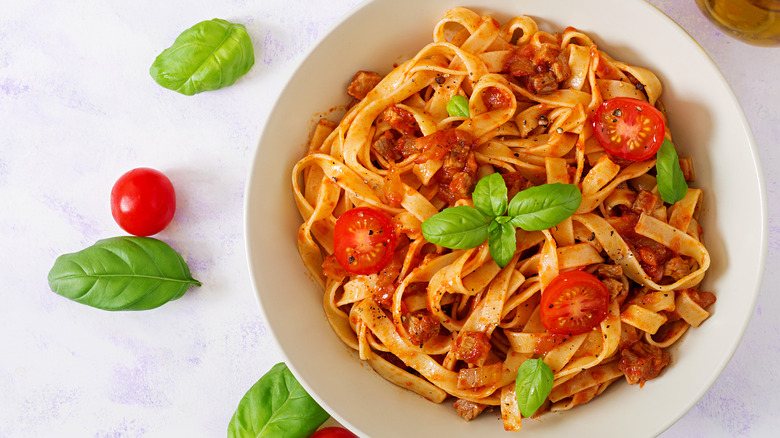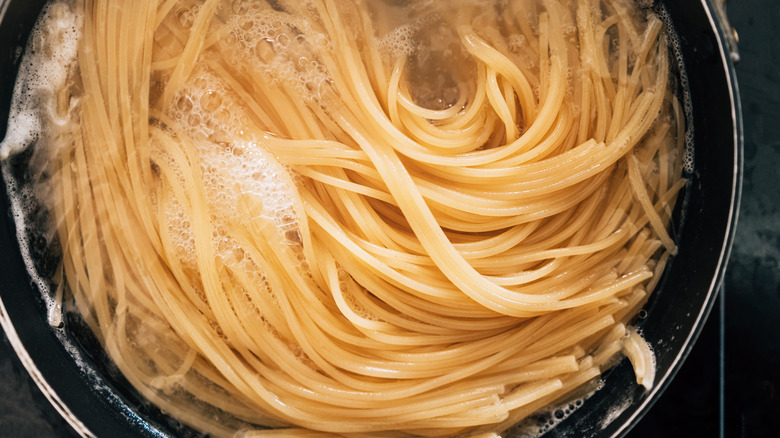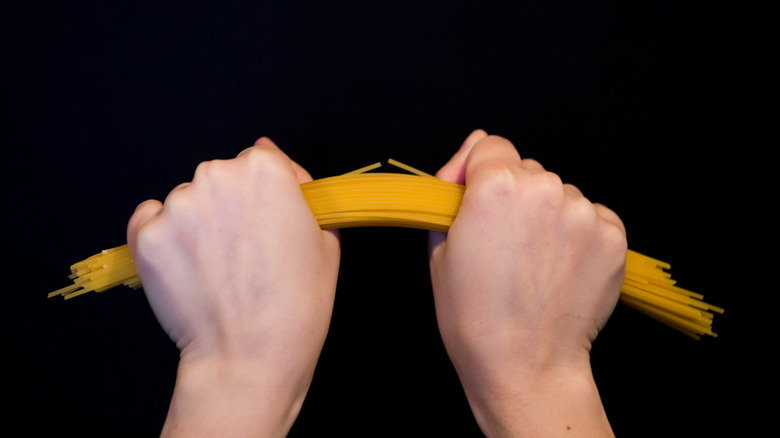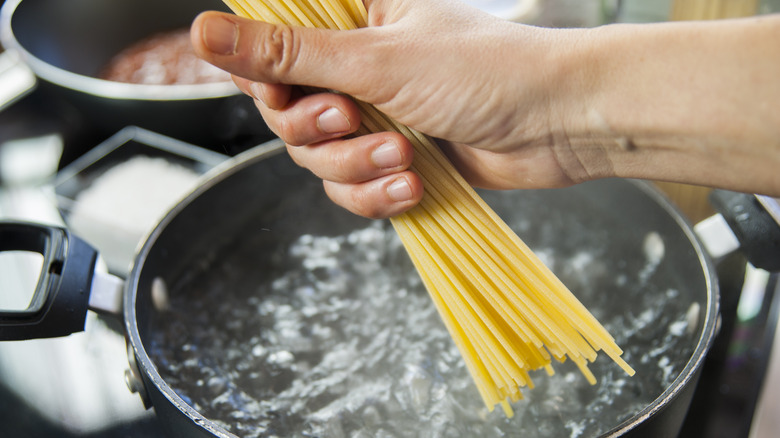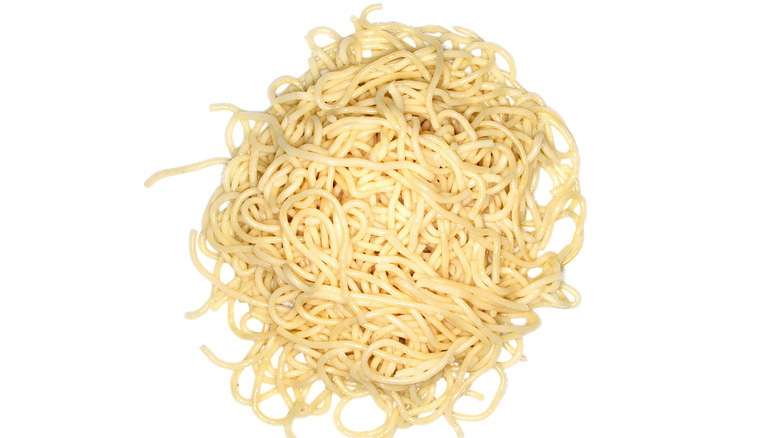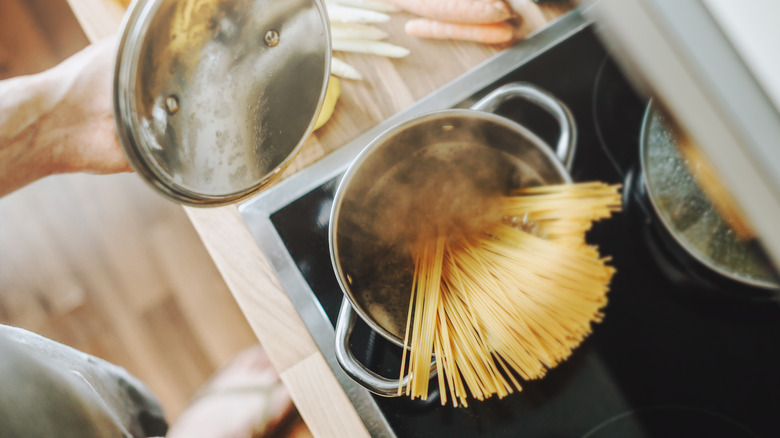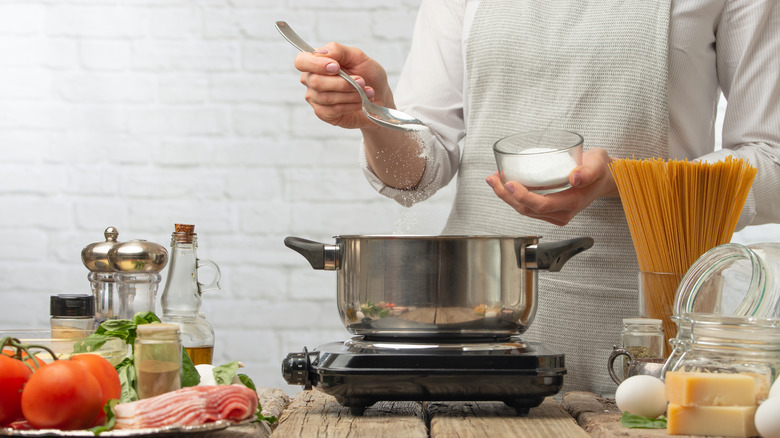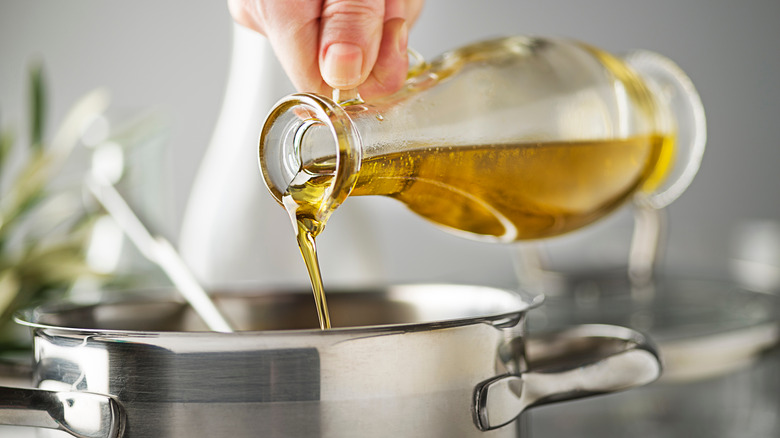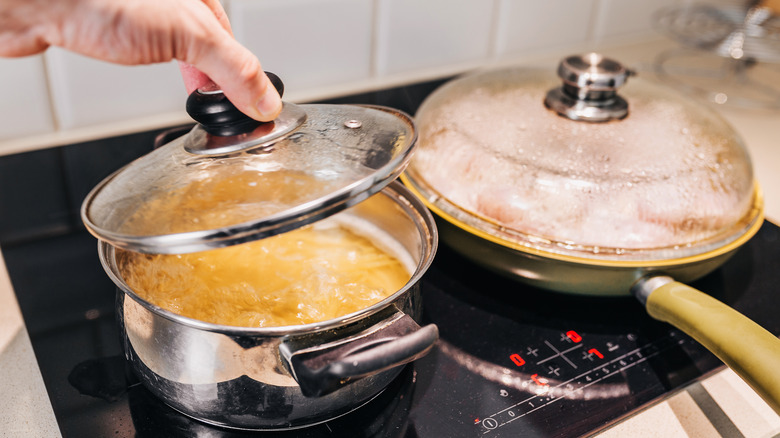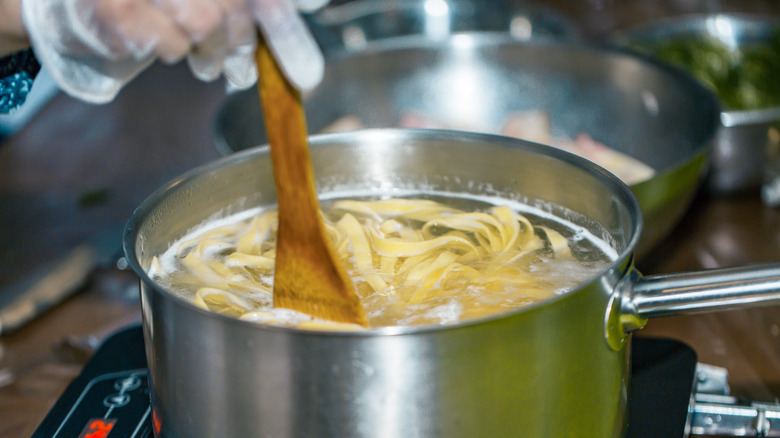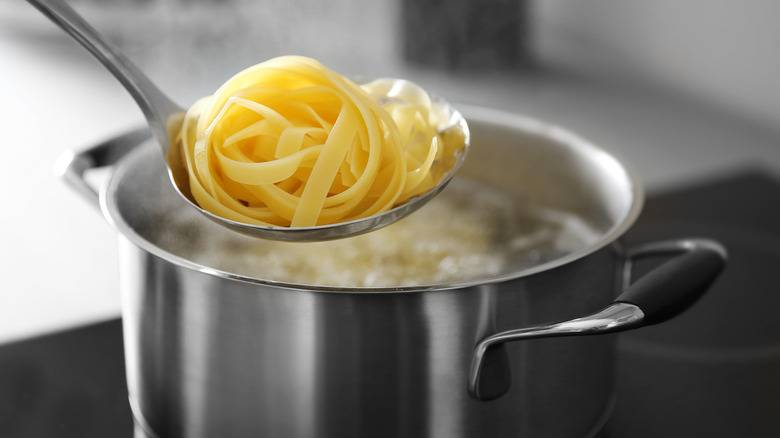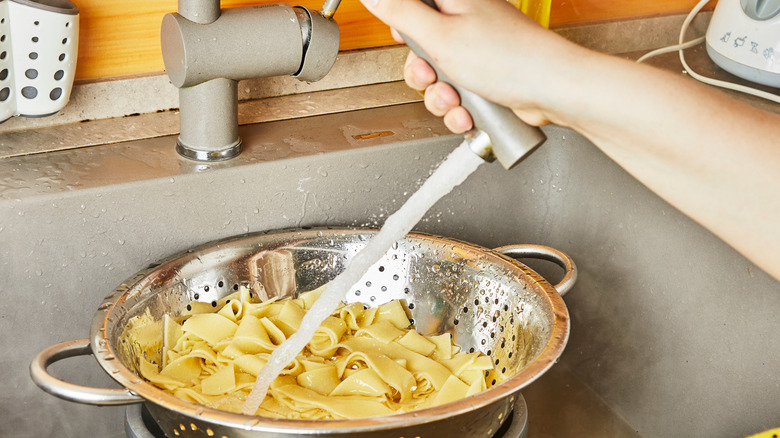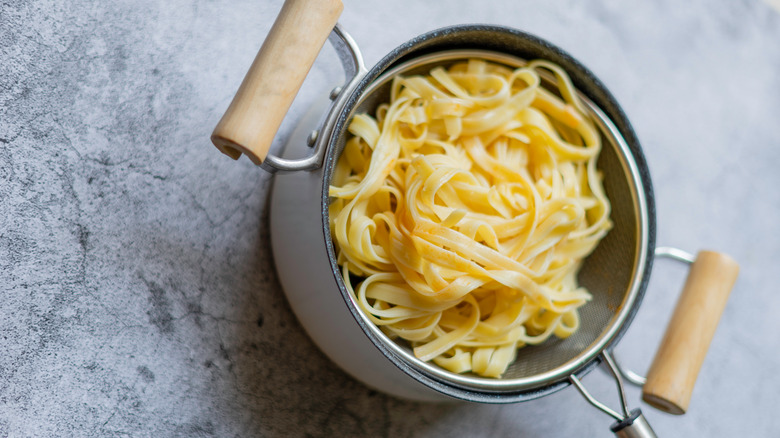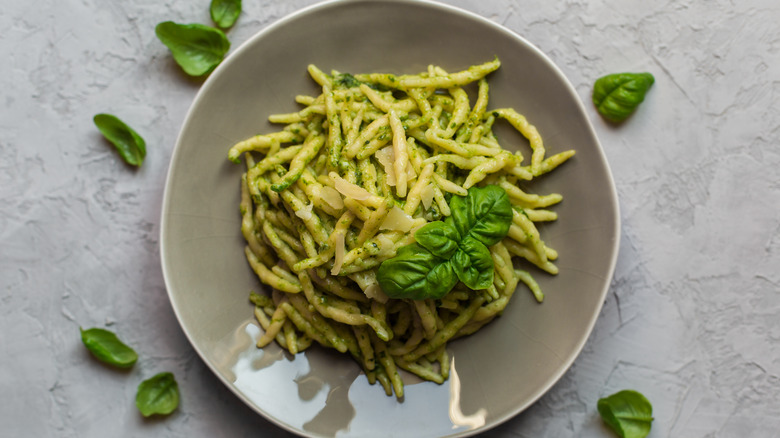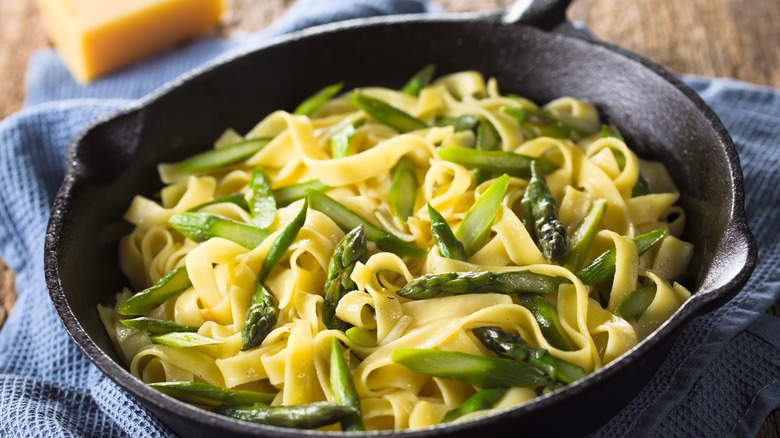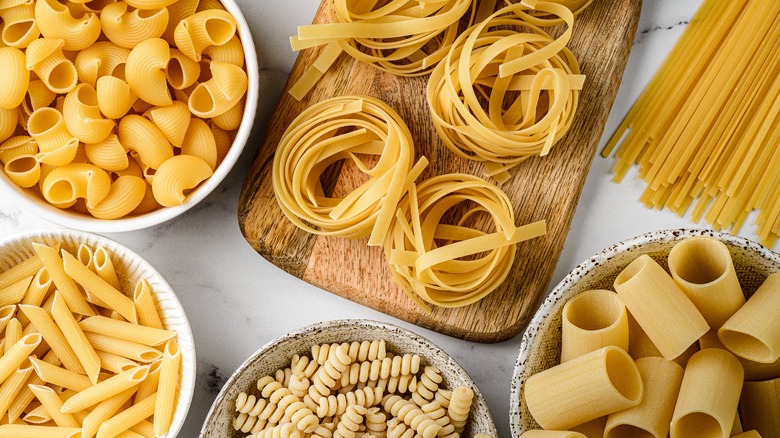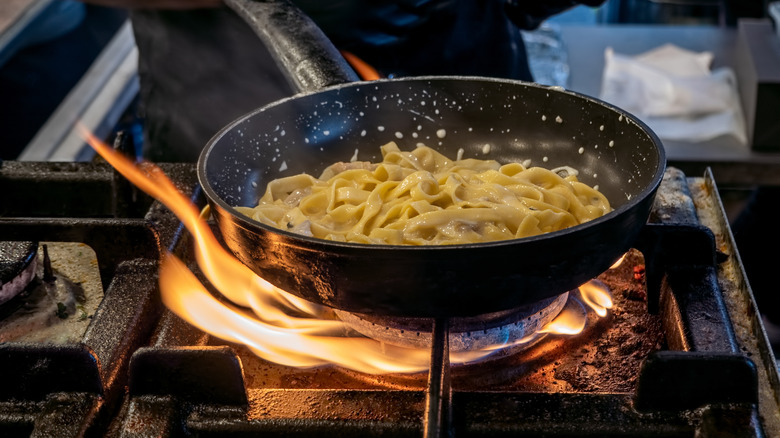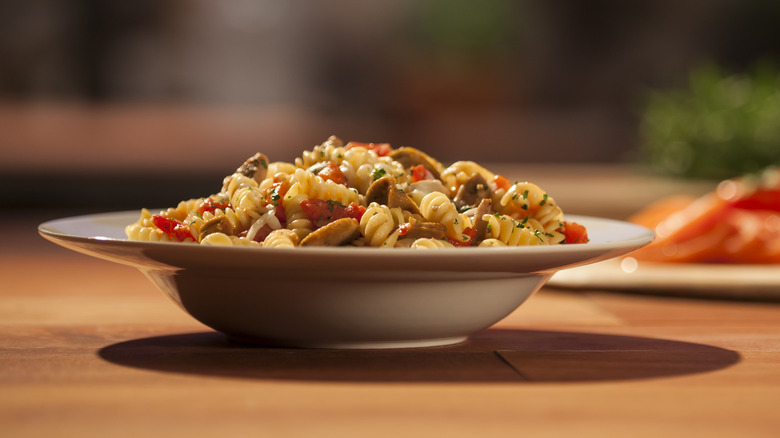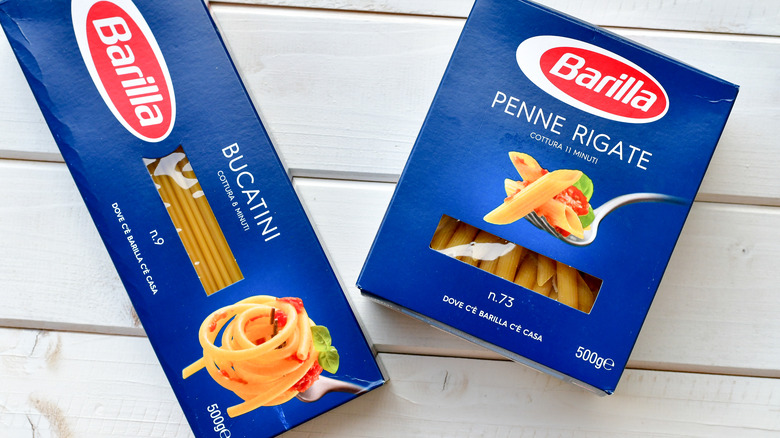The 19 Biggest Mistakes You're Making With Pasta
Pasta receives plenty of glory as being an easy dish to whip up when you're low on time, energy, and ingredients. And while it certainly deserves all of the praise, the starchy high-carb dish often fails to live up to its potential. No thanks to supposed shortcuts or bad habits, you're doing both the pasta and yourself a disservice. You don't need to have the technique and precision of a professional chef to cook pasta, but there are some key elements that will significantly improve your culinary experience.
There are of course personal preferences when it comes to how people like their pasta, so you're welcome to take these tips with a grain of salt (as long as you don't skimp on the salt in your cooking water). Nonetheless, it really doesn't require much more work to make an excellent plate of pasta, so it's well worth the effort. Plus, sometimes you don't really know how great a dish can be if you've always had it the same way. Take notes, and we guarantee that your pasta nights will soon be greatly enhanced.
Using a pot that is too small
Perhaps you're in a rush and the first pot you grab is small but should be able to fit your pasta, so you just go with it. Maybe you're multitasking in the kitchen and your largest pot is currently in use. Regardless, your best bet for making pasta that will cook evenly without sticking into a clump is to give it some space to boil. Besides the fact that you're not allowing the pasta to float around freely as it cooks, a smaller saucepan means less water. If you consider what happens to a pot of boiling water when you add pasta, it follows that a smaller quantity of water will decrease in temperature more rapidly than a larger amount. You'll have better luck keeping the temperature and, in turn, the cooking more consistent if you start off with more water.
As well, pasta releases plenty of starch as it cooks, consequently increasing the starch content in the pot. If you're using a minimal amount of water, the outlet calls the result "pasta pudding." If you're like us, you prefer your pasta to taste and feel like pasta and your pudding to be gelatinous like a proper pudding should be. So how much water should you be using to avoid this dubious result? The general consensus is that you should boil a minimum of four quarts of water per pound of pasta.
Breaking long noodles to make them fit
There are at least 350 pasta shapes, according to Italy Magazine, and many do indeed fit into the longer noodle category. If you usually cut your linguine into bite-sized pieces and shovel them into your mouth with a spoon, breaking pasta before cooking it probably doesn't seem like a big deal. However, if you'd eventually like to swirl strands of spaghetti around your fork, then the first step is retaining their length.
If you've committed mistake number one and are trying to fit your pasta into a pot that can't actually accommodate it, you'll probably break your spaghetti in half. Even with larger pots, the noodles might poke out for 30 seconds, but they will quickly soften enough to easily fit. Although the pasta's cooking properties won't change if it's broken, the point of long pasta is to wrap it around your fork. Pretty much all Italian chefs and citizens strongly oppose snapping pasta in half to fit it into a pot. If you don't want to swirl it, then pick another shape — there are hundreds to choose from.
Adding the pasta before the water is boiling
Here's another shortcut that has sparked many discussions about the best way to cook pasta. To make it the traditional Italian way, First boil cold tap water, add the salt, and finally toss in the pasta. Indeed, if you wait for 4 to 5 quarts of water to come to a boil, you might be waiting a short wile. Since pasta is often selected as a speedy dinner option, it follows that many people choose to skip the waiting part.
Alton Brown is one famous (distinctly not Italian) chef who is on board with what he calls the cold water pasta method. Aside from the potential wrath from an Italian grandmother or foodie, adding pasta to water that has not yet begun to boil can be a recipe for disaster. During the time it takes for cold water to boil, it undergoes a wide fluctuation in temperature. Instead of throwing the pasta in and giving it the occasional stir, you'll have to keep a close eye to estimate the pasta's doneness.
Pasta expert Anthony Contrino tells Today that salt won't dissolve properly in cold water, which means that it won't impart as much flavor. Meanwhile, chef Palak Patel explains to HuffPost that more starch is released from pasta in cold water, which can result in a soft texture — essentially the opposite of the idealized al dente.
Overcooking your pasta
There are definitely personal preferences when it comes to the ideal pasta texture, but if you want to avoid mushy spaghetti reminiscent of a school cafeteria, you'll want to prepare it al dente. The term translates in Italian to mean "to the tooth," as in the pasta should retain some bite. Instead of being completely cooked through into a soft pulp, al dente pasta has layers of texture. The exterior is softer, and as your teeth reach the center there is greater resistance to the bite. While it might sound incredibly precise, it's pretty easy to identify after you've tasted al dente pasta a few times.
Cook your pasta molto al dente (very al dente) if you are planning to finish it off in a sauce, by draining it a few minutes before you usually would. A taste test is always your best bet, but some pasta boxes will also indicate an al dente cooking time which you can follow. No matter what, don't let the pasta keep sitting in the hot water once it's ready.
If you wanted another reason to cook your pasta al dente, it has a lower glycemic index than if it's overcooked. The source reports that with a higher glycemic index, your blood sugar rapidly increases and decreases, causing a sudden drop in energy and immediate hunger.
Undercooking your pasta
Of course, there is a limit to al dente, and undercooking your pasta can be equally unpleasant as a mushy bowl of noodles. Unless you are completing your pasta in a sauce on heat, check that you are satisfied with the doneness by taking a bite before draining away the water. There's chewy and then there's hard and undercooked — you'll quickly realize the distinction. If you're still getting the hang of it, as long as you're throwing your pasta into a pot of boiling water, the timing indicated on the package should be fairly accurate.
If you realize a moment too late that your pasta's undercooked and you've already drained the water, you have a few recourses. You can actually reboil your pasta — just be sure that the water is already boiling before adding the pasta back. You'll also want to keep tasting every 30 to 60 seconds to prevent erring on the other end of the spectrum. However, if you've just underdone it by a bit, add the pasta to a pan with the sauce you plan to serve it in and simmer it for a few minutes.
Not salting the water
If you've always been undersalting your pasta water then you will probably be shocked when you see how much salt is considered to be the right amount according to Italians and pasta experts. In fact, a traditionally held belief is it should be so salty as to evoke the sea. If you're wondering exactly how much salt is required for the seawater effect. If you're boiling 5 quarts of water for about 1 pound of pasta, you're going to want to add in ⅓ cup of kosher salt. If you're not using coarse salt, then 1 to 2 tablespoons per pound of pasta should suffice.
While it sounds like a huge volume, the salt dissolves in the boiling water and serves to flavor the resulting pasta. Instead of adding tons of salt to the final dish, As the pasta absorbs water, it also soaks in salt which affects the taste. Keep in mind that if you're making a highly salted sauce, such as with olives or anchovies, you can stick to the lower end of the scale. Again, salt is often a matter of personal preference, but if you are using just the right amount, you will only notice overall enhanced flavors.
Adding olive oil to the water
It can be tempting to splash in some olive oil to ensure that your pasta doesn't stick, but if you're planning to add any sauce then you'll want to take a step back. What appears to be a foolproof shortcut to avoid having to stir your pasta regularly as it cooks will in fact come back to ruin your dish. Take it from the pasta makers at Barilla, who instruct against adding olive oil to the water, explaining that it only causes the pasta to become overly slick. As the pasta boils, it absorbs water, and if you've added it, oil too.
Sure the pasta won't stick to itself, but neither will the sauce you've carefully prepared (or removed from the jar) to accompany it. If you often end up with a pile of sauce at the bottom of your bowl, adding olive oil at the wrong time might be to blame. Instead, make sure to use a large pot with sufficient water and stir your pasta a few times as it cooks to prevent sticking. Once your pasta is drained and ready to serve, you can drizzle on some olive oil and actually taste the flavor.
Covering the pot once the pasta is in
When you first set a pot of water on the stovetop to boil, keeping the lid on is a good way to speed up the process. As long as you don't leave for an extended period of time or overfill the pot, you shouldn't have to clean up any mess. If you're staying close to the stove, once you add the pasta you can keep the lid on to allow the water to quickly come back to a boiling point. However, the second the water is bubbling again, remove the lid and leave the pasta uncovered as it cooks.
The main issue with keeping the lid on as the pasta cooks is that your pot will very quickly overflow, causing a mess and reducing the amount of water in the pot. We've already explained why you want a lot of water, and if you haven't figured out that it's more pleasant to avoid a mess in the kitchen... well, you'll realize after the hundredth time you're cleaning your stovetop.
Finally, if the lid is off then you'll be more inclined to stir your pasta regularly, which means you won't feel the need to add unnecessary olive oil to the water. Basically, it's an all-around win.
Not stirring the pasta while it cooks
Since we've established that adding olive oil to your pasta water isn't the right move, let's focus on the appropriate alternative. Stirring your pasta as it cooks, especially right after you add it to the pot is the best way to avoid a clumpy result. The starches contained in pasta basically act like glue as they are released and begin to dissolve in the surrounding water. If your pasta is close together instead of floating freely, then it will stick much more easily. The simplest way to avoid this result is by stirring it often.
Another issue is that pasta sinks to the bottom when you toss it into the pot. If you consider that the metal base of the pot is extremely hot since it is in close contact with the burner, it follows that without stirring, the pasta will stick to the bottom. You don't have to continuously stir your pasta — save the arm workout for risotto — but you should pay attention during the first few minutes when most of the starches are released.
Not tasting the pasta as it cooks
Great cooks don't become that way by blindly pushing ahead from prep to service without ever stopping to try the food. When you taste a dish as it's being made, you have a much greater chance of being able to make adjustments to ensure that the final result is successful. Even though cooking pasta only involves three ingredients (pasta, water, and salt), timing is essential.
Some packaging indicates an al dente cook time, and as long as you are adding your pasta to boiling water and setting the timer, then it should be fairly accurate. However, to ensure that the pasta is up to your standards — especially if you will be cooking it further in sauce — a simple taste test is your best bet. Check two to three minutes before the timer rings and aiming for a firm texture when you take a bite. It definitely shouldn't be entirely white on the inside, but a hint of color variation confirms that you haven't overdone it.
Rinsing the pasta after it's cooked
If your mind is set on the notion that rinsing pasta stops the cooking after you've drained away the water, you're right — but that's not the only element to consider. We'll give you the benefit of the doubt and assume that you only rinse pasta when it enhances the final result. If you're planning to use the pasta for a cold salad or stir fry, then a rinse is the right step. It eliminates starches on the outside of the pasta, which in these circumstances would congeal and stick once the pasta cools down or is stir-fried.
Meanwhile, if you are serving your pasta hot with a sauce, rinsing it after you remove it from the heat will be doing your meal a disservice. The sticky starch shines when it comes to getting sauce to coat your pasta. Thanks to the glutinous exterior, the pasta can easily absorb the sauce so that each bite contains a balanced and flavorful combination of sauce and pasta.
Draining all of the pasta water
When you consider all of its ideal properties, pasta water is almost as important as the sauce. As we've described, while the pasta is cooking in the salted water, it releases starches which essentially behave as thickening agents. Although they can be a nuisance and cause your pasta to stick if you forget to stir it, the starches provide a great backbone to your sauce.
Starchy pasta water is especially useful when making an egg based sauce (hello carbonara) to avoid a potential curdling effect with the sudden increase in temperature once the pasta is added. Pasta water gives even the simplest sauce a delicious silky consistency, adding that it is particularly beneficial for sauces you whip up in a pan.
To retrieve some of the pasta water, you can either first remove a ladle or two and set it aside, or place a bowl under your colander to catch the excess drain-off. Alternatively, Martha Stewart recommends using a mesh spider strainer, which is basically a cross between a scoop and a strainer.
Not using the best pasta shape and sauce combinations
It might seem finicky to suggest that certain shapes of pasta are meant to be combined with specific sauces, but as far as regional Italian cuisine goes, it's the tradition. Like all varieties of food, pasta shapes have their own place of origin in areas of the country which also specialize in certain sauces. Sure, you're welcome to create your own pairings, but most combinations come to be because they work so well together.
Take any pasta with twists and turns — the nooks and crannies are designed to hold tiny pieces of ingredients that have been mixed into the sauce. A prime example is pesto: With its small chunks of basil, pine nuts, and Parmesan, it is traditionally served with trofie, a spiral shape of pasta. Similarly, it can be served with flat linguine which are easily coated in the thick sauce. Forget fussy, pasta and sauce pairings are purely functional. Why dress stuffed ravioli with a flavor heavy sauce? A simple butter or olive oil sauce will do the trick. Choosing the optimal pasta and sauce duo is an easy way to enhance your culinary experience.
Not finishing your pasta in the sauce
While it's understandable to want to get dinner on the table as quickly as possible, taking the extra step and finishing your pasta in its sauce will make it that much better. First of all, this makes it easy to add a splash of pasta water to combine all of the flavors and starches. The effect isn't quite the same if you pour the water directly into your serving bowl. Giving the pasta and sauce a quick simmer helps the flavors unite and allows the sauce to coat more easily. Be sure to slightly undercook your pasta before tossing it into the sauce and heat it up quickly at a high temperature with the sauce.
By combining the sauce and the pasta prior to service, you are less likely to accidentally overdo it on the sauce in your bowl. We recommend using 1 ½ cups of sauce for each pound of pasta served, and reducing the amount if it is oil or cream-based. As for extra toppings like herbs or grated Parmesan, garnish your dish once it's off heat so that they retain their freshness.
Not buying the best quality pasta you can afford
Although there are some ingredients worth skimping on, high-quality pasta is worth the extra few dollars per parckage. Mass-produced low cost pasta is speedily dried at high temperatures in order to be quickly packaged and sold. In turn, the pasta's texture is smooth and shiny, basically the opposite of the desirable features that allow sauce to stick. The better quality stuff has a rougher exterior which promotes sauce absorption, making for a better bowl of pasta all-around.
Higher quality pasta spends more time drying at lower temperatures which enhances the final texture. Plus, more expensive pasta is made using traditional bronze molds compared to shiny new Teflon versions. Bronze molds create a rougher, more porous pasta texture which is the element that allows sauces to infuse their flavor. If your sauce never seems to stick to your pasta, you might want to consider shelling out a couple of dollars more to try a better quality of pasta. Not only will it successfully hold onto sauce, you'll also have a greater chance of tasting the perfection of an al dente preparation thanks to its superior structure.
Not cooking the pasta directly in the sauce
This shortcut goes a step beyond finishing the pasta in sauce. Instead of boiling it in water and combining it with sauce in a pan, minimize the cleanup by cooking the pasta directly in the sauce rather than in water. This easy method saves effort and produces a thick and creamy result since the starches from the pasta end up in the sauce. That being said, you'll want to keep a few points in mind to avoid pasta soup or conversely, a dry and undercooked dish. Also, it's worth noting that long pasta won't do as well unless you have a pot that's large enough to cover it entirely with sauce.
Whether you start from scratch and make your own sauce or dump a jar of bolognese into a large pot, it's important to have sufficient liquid. As the pasta cooks it will absorb moisture and release starch, which means you shouldn't be adding dry pasta to a sauce with a ready-to-serve consistency. If you're following a one-pot pasta recipe, the proportions should be appropriately adapted.
However, if your process is more experimental, add a few cups of liquid to a pot with the sauce and pasta. If you notice the contents begin to dry out before the pasta is cooked, just pour in some extra liquid. A combination of broth, water, and cream is an easy way to add plenty of flavor to the final dish.
Waiting too long to serve it
Even though pasta salad is made with the intention of being served at room temperature, not all pasta tastes good after it's been sitting for a while. Granted, the USDA doesn't recommend consuming any food after it's been unrefrigerated beyond two hours, but in the case of freshly cooked pasta, the timeline is even shorter. Aside from food safety concerns, leaving a bowl of pasta out will affect its overall quality and texture.
Unfortunately, a food-borne pathogen called bacillus cereus can quickly start to grow on cooked pasta, since it has the benefit of being resistant to heat. The longer the pasta sits out before you consume it, the greater chance the bacteria has of thriving and ending up in your gastrointestinal system.
Aside from all the negative health effects, the starches in the pasta will start to stick together after time. The best way to avoid this outcome is not to let your pasta sit in the colander after draining it. Add sauce immediately and consume the meal once it's ready. If you're cooking extra pasta for lunch tomorrow, you may want to rinse that portion before storing it to prevent it from sticking. Of course, this is an exception — you should avoid rinsing your pasta if you're planning to serve it right away with sauce.
Thinking that boxed pasta lasts forever
Keeping dry goods in stock ensures you always have something to eat, but if you've been holding onto boxes of pasta that are several years old, they may be to blame for your subpar dinner. Dried pasta has been a common long-term food option for centuries, thanks to its minimal moisture content, with a shelf life of around two years, per the FDA. While it is unlikely for dried pasta to develop mold or bacteria, certain storage mistakes and conditions can have an impact on its longevity.
Leaving the box in the sun, in a humid space, or somewhere with large temperature fluctuations may compromise quality. Additionally, standard cardboard boxes or plastic packaging can break, allowing moisture to come into contact with the dried pasta. If you notice an issue with the container immediately, just transfer the pasta to a sealed glass jar. If the pasta is cracked or its texture is somewhat altered, just toss it in the compost and start fresh.
Although in most cases you'll be fine cooking an old box of pasta you unearth at the back of your pantry, if you want to enjoy an optimal meal, give it the most opportunity to shine. Consume it prior to its best-before date and ensure that you store it away from light and moisture.
Making too much pasta
Pasta is great, so more pasta is better... right? Well, not quite. While you might sometimes plan to cook extra to have for lunch the next day, it's best not to overdo it. For starters, if it's going to be sitting out untouched, it's likely to become sticky and gloopy — who wants those leftovers? If you are storing it, more pasta means a longer time to cool down before it can safely be refrigerated, and in turn, more time for bacteria to grow.
Chair of the Food Safety Information Council Rachelle Williams explains that cold pasta can only safely be reheated once since bacteria can withstand heat and continue to thrive when it's back in the fridge (via HuffPost). To avoid any possible food-borne illnesses, avoid making far more pasta than you need — after all, it doesn't take very long to cook. Aside from the possible health issues, reheated pasta just isn't the same as a freshly boiled portion.
